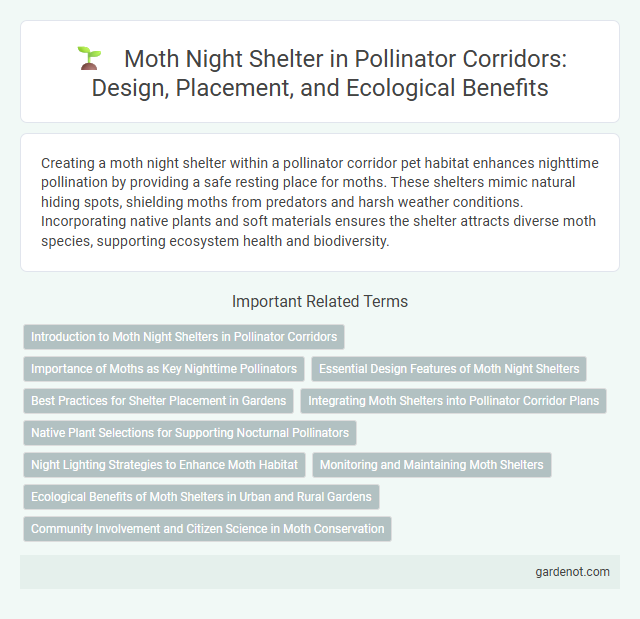Creating a moth night shelter within a pollinator corridor pet habitat enhances nighttime pollination by providing a safe resting place for moths. These shelters mimic natural hiding spots, shielding moths from predators and harsh weather conditions. Incorporating native plants and soft materials ensures the shelter attracts diverse moth species, supporting ecosystem health and biodiversity.
Introduction to Moth Night Shelters in Pollinator Corridors
Moth night shelters in pollinator corridors provide essential resting habitats that protect moths from predators and harsh weather conditions. These structures enhance nighttime pollination by supporting moth populations critical for maintaining biodiversity and ecosystem health. Integrating moth night shelters within pollinator corridors promotes effective pollinator conservation and strengthens pollination networks.
Importance of Moths as Key Nighttime Pollinators
Moths are essential nighttime pollinators, facilitating the reproduction of numerous nocturnal flowering plants through their efficient transfer of pollen under the cover of darkness. Their role in pollinator corridors is critical for maintaining biodiversity, as moths support the survival of plant species that rely exclusively on night pollination. Protecting moth night shelters ensures these pollinators have safe habitats, sustaining ecosystem health and agricultural productivity.
Essential Design Features of Moth Night Shelters
Moth night shelters require essential design features such as tight, overlapping slats or panels that mimic tree bark to provide secure resting spots and protection from predators. Incorporating a dark, sheltered interior with minimal light exposure enhances the moths' sense of safety, encouraging nocturnal activity. Proper ventilation and moisture control within the structure prevent mold growth and support healthy moth populations in pollinator corridors.
Best Practices for Shelter Placement in Gardens
Choose sheltered garden areas with dense vegetation or clustered shrubs to provide moths protection from wind and predators during nighttime. Position shelters away from bright artificial lights to maintain natural darkness crucial for moth activity and rest. Incorporate native plant species around shelters to ensure sustainable food sources and favorable microhabitats supporting diverse pollinator populations.
Integrating Moth Shelters into Pollinator Corridor Plans
Integrating moth night shelters into pollinator corridor plans enhances habitat connectivity by providing safe resting sites for nocturnal pollinators essential to ecosystem health. These shelters support moth populations by offering protection from predators and harsh weather, promoting higher survival and pollination rates of native plants. Strategic placement of moth night shelters along corridor routes maximizes biodiversity benefits and strengthens pollinator network resilience.
Native Plant Selections for Supporting Nocturnal Pollinators
Native plant selections such as evening primrose (Oenothera spp.), moonflower (Ipomoea alba), and night-blooming jasmine (Cestrum nocturnum) provide essential nectar sources for nocturnal moth pollinators. These plants emit strong, sweet fragrances at night, attracting moths and supporting their feeding and reproductive behaviors. Incorporating diverse native night-blooming plants enhances the moth night shelter by sustaining local ecosystems and promoting biodiversity within pollinator corridors.
Night Lighting Strategies to Enhance Moth Habitat
Effective night lighting strategies for moth night shelters prioritize low-intensity, warm-spectrum LED lights that minimize disruption to moth behavior and navigation. Implementing motion-activated or timed lighting reduces unnecessary illumination, preserving natural darkness essential for moth activity. Shielded fixtures and downward-directed lighting prevent light pollution, supporting a vibrant pollinator corridor by enhancing moth habitat connectivity and biodiversity.
Monitoring and Maintaining Moth Shelters
Monitoring moth night shelters involves regular inspections to track species diversity and population health using nocturnal light traps and visual surveys. Maintaining these shelters requires ensuring suitable habitat conditions such as host plant availability, moisture levels, and protection from predators or extreme weather. Data collected supports adaptive management strategies to enhance shelter effectiveness within pollinator corridors.
Ecological Benefits of Moth Shelters in Urban and Rural Gardens
Moth night shelters provide essential resting habitats, enhancing moth survival rates by offering protection from predators and harsh weather conditions. These shelters support biodiversity by maintaining moth populations critical for pollination and serving as a food source for urban and rural wildlife. Integrating moth shelters into pollinator corridors promotes ecological balance and strengthens pollination networks within diverse garden ecosystems.
Community Involvement and Citizen Science in Moth Conservation
Community involvement in moth conservation thrives through citizen science initiatives that encourage local participation in creating and monitoring moth night shelters. These shelters provide safe habitats for nocturnal pollinators while enabling volunteers to collect data on moth species diversity and population trends. Engaging communities in moth conservation fosters environmental awareness and supports biodiversity protection by leveraging citizen observations and collaborative research.
Moth night shelter Infographic

 gardenot.com
gardenot.com